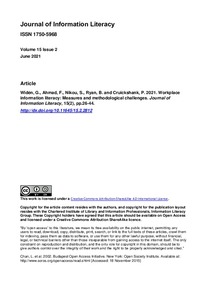Workplace information literacy: Measures and methodological challenges
Ryan Bruce; Widén Gunilla; Ahmad Farhan; Nikou Shahrokh; Cruickshank Peter
Workplace information literacy: Measures and methodological challenges
Ryan Bruce
Widén Gunilla
Ahmad Farhan
Nikou Shahrokh
Cruickshank Peter
CILIP
Julkaisun pysyvä osoite on:
https://urn.fi/URN:NBN:fi-fe2021093048395
https://urn.fi/URN:NBN:fi-fe2021093048395
Tiivistelmä
- This paper focuses information literacy (IL) from a methodological perspective, addressing quantitative IL measures, suitable for evaluating the role of IL in supporting work activities. So far, IL in workplace contexts has mostly been studied using qualitative methods, designed for studying situational and context-dependent practices. Therefore it is important to explore how quantitative measures could be used to bring forward the relation between IL and organisational outcomes, that is the assessment of the impact of IL in workplace contexts. Quantitative research into IL is not unknown, but has been mainly developed in higher education, in order to measure students' abilities to make use of information. This paper brings forward three separate studies, conducted by the authors, highlighting different workplace contexts: small and medium enterprises; universities; and community councils. The common approach is that survey instruments were used to measure IL and its impact in these organisational contexts. The methodological implementations and insights are presented and combined, and methodological strengths and challenges are discussed, with the aims of (1) building knowledge about IL measures in workplace settings that is currently lacking, (2) finding additional measures for the complex IL construct, and (3) considering the scope of the practices that can be measured. The paper highlights the complexity of studying the impacts of IL in workplace contexts, and the importance of using multiple methods. It constitutes an important step towards a more unified understanding of how to study workplace IL.
Kokoelmat
- Rinnakkaistallenteet [19207]
